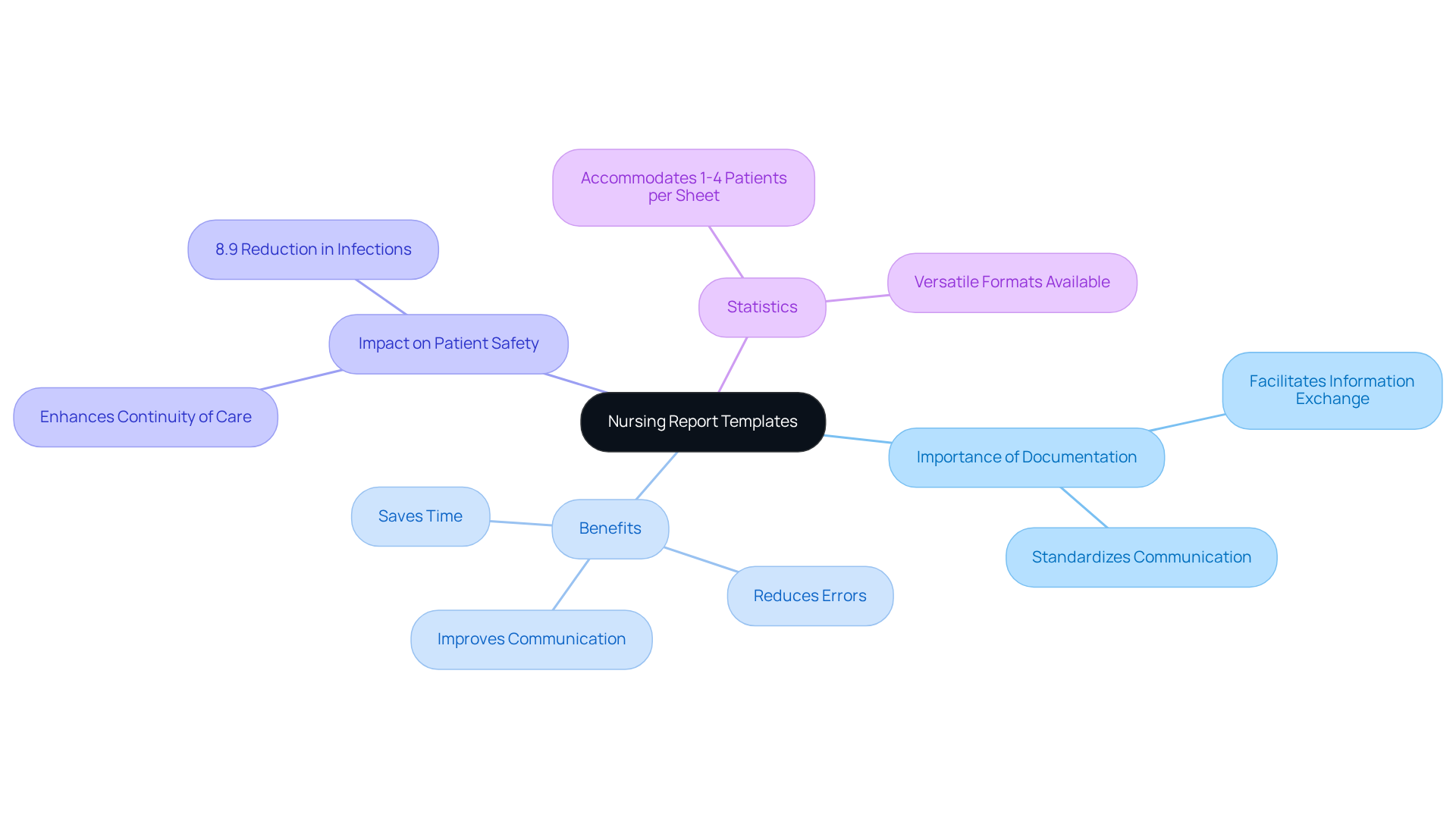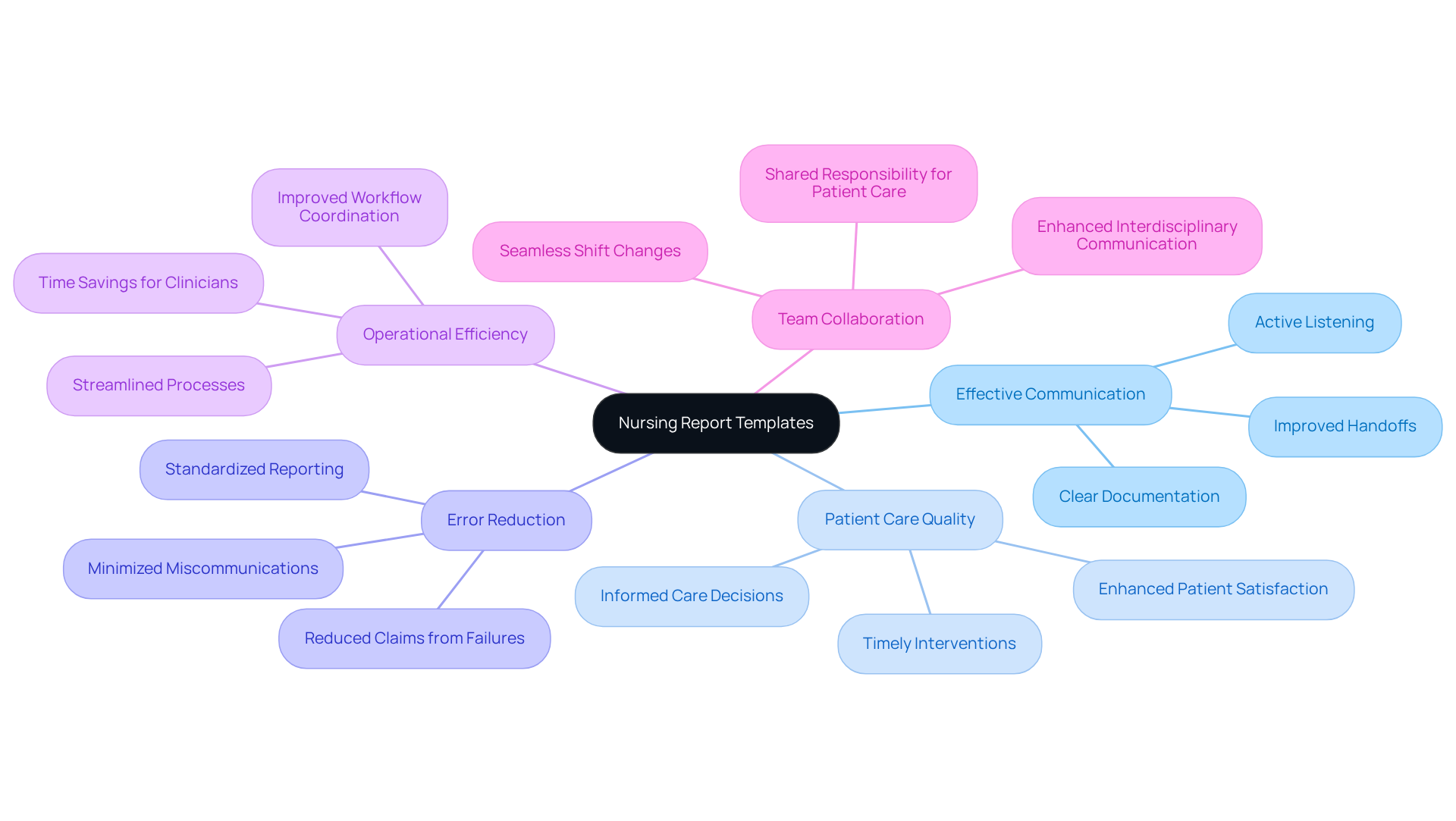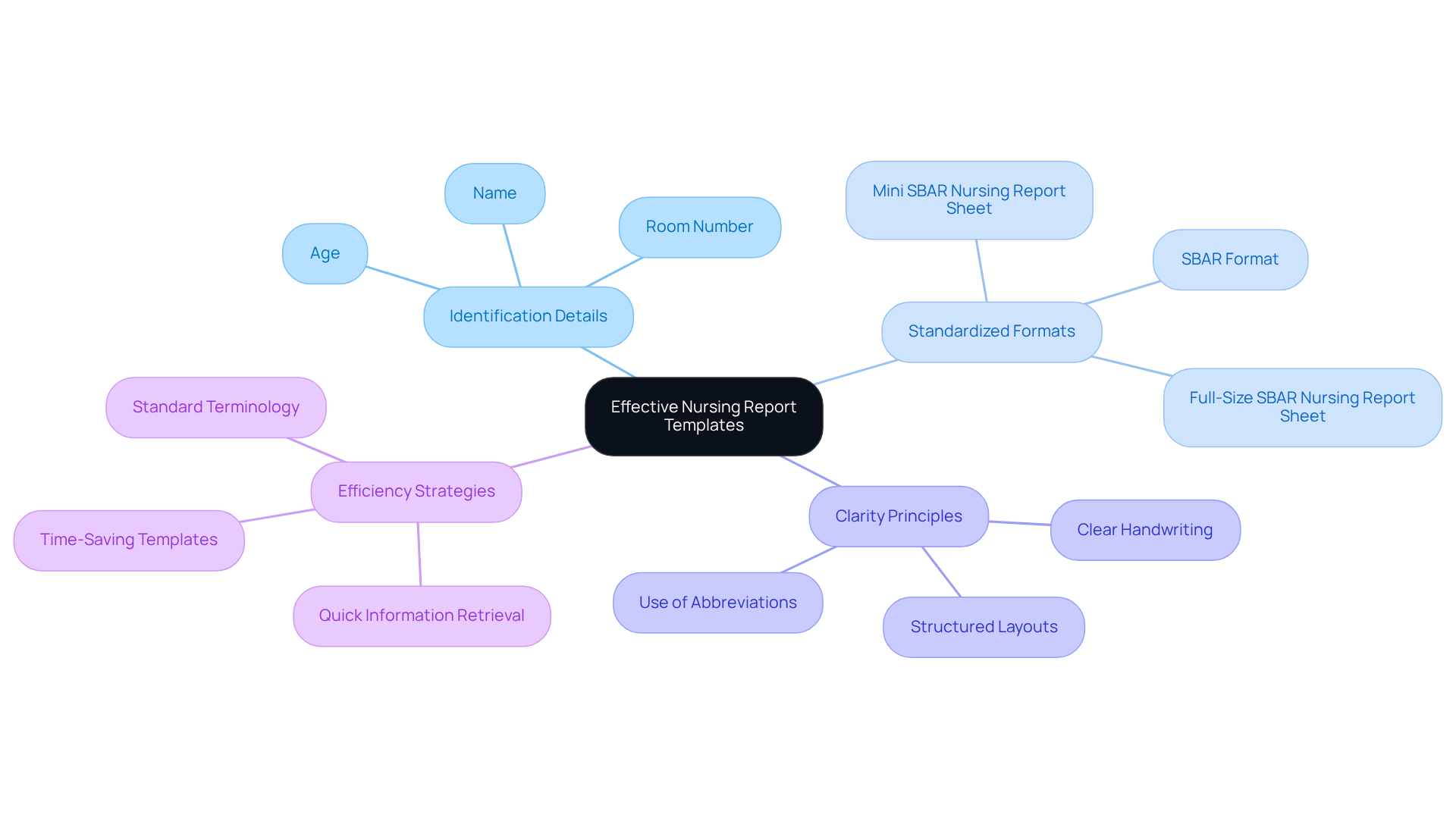Overview
Nursing report templates serve as vital tools that nurture patient care by fostering communication, minimizing errors, and ensuring seamless transitions during shifts. Have you ever felt overwhelmed by the challenges of maintaining clear communication in a busy healthcare environment? This article underscores the importance of structured documentation, revealing that it significantly reduces miscommunication-related adverse events. By cultivating a culture of safety, we can work together to achieve better health outcomes for our patients.
Imagine a world where every shift change is smooth, where vital information is shared effortlessly, and where patient safety is always prioritized. By implementing nursing report templates, healthcare providers can alleviate some of the administrative burdens that often detract from direct patient care. These templates not only enhance communication but also empower staff to focus on what truly matters—the well-being of their patients.
Let us embrace these tools and take a step towards improving our practice. Together, we can foster an environment that values safety and clarity, ultimately leading to a more compassionate and effective healthcare experience for everyone involved.
Introduction
Nursing report templates play a crucial role in fostering effective communication within healthcare. They transform the documentation and sharing of vital patient information among medical teams. By standardizing this process, these templates enhance clarity and significantly reduce the risk of errors during critical handoffs. But what happens when the very tools meant to streamline communication are overlooked in the hectic pace of healthcare?
This article explores the essential components and benefits of nursing report templates. It reveals how these tools can elevate patient care and promote a culture of safety and accountability within medical practices. In a field where every detail matters, understanding and utilizing these templates can make a profound difference in the quality of care provided to patients.
Are you ready to discover how these templates can support your practice? Let’s delve into how they can alleviate some of the administrative burdens that often weigh heavily on healthcare providers, allowing you to focus more on what truly matters: your patients.
Defining Nursing Report Templates: A Comprehensive Overview
Caregiving documentation forms, often referred to as caregiving sheets or brain sheets, play a crucial role in the lives of nurses. These organized papers are essential for documenting and sharing vital personal information during shift transitions, ensuring that no detail is overlooked. They facilitate the exchange of important information, such as individual demographics, medical history, current health status, and ongoing care plans. By standardizing the documentation process, these templates help guarantee that vital information is communicated clearly and efficiently, ultimately enhancing safety and continuity of care.
Have you ever considered how administrative burdens can impact patient care? Research suggests that employing a nursing report template can significantly reduce the likelihood of mistakes and omissions that often arise from free-form records. For example, a study revealed that hospitals implementing structured reporting formats experienced a notable decrease in adverse events related to miscommunication during handoffs. Furthermore, these care documentation sheets can accommodate 1-4 individuals per sheet and offer options for both portrait and landscape formats, making them versatile for various clinical environments.
The effectiveness of these models is underscored by their ability to improve safety statistics for individuals receiving care. A case analysis, for instance, showed that hospitals utilizing care documentation saw an 8.9% reduction in pneumonia infections among surgical individuals. This connection between enhanced communication and improved outcomes highlights the essential role that a nursing report template plays in fostering a culture of safety and accountability within medical teams.
In summary, healthcare documentation formats are far more than administrative tools; they are vital components of effective care. They enhance communication, reduce errors, and ultimately contribute to improved safety outcomes. Let’s embrace these tools to support one another in our shared mission of providing compassionate and effective care.

The Role of Nursing Report Templates in Enhancing Patient Care
The nursing report template is an essential tool that significantly enhances the quality of care by fostering effective communication between nursing shifts. These templates empower nurses to swiftly access vital information about individuals, which is crucial for making informed care decisions. Have you ever considered how a well-structured documentation sheet can help nurses quickly identify changes in a person's condition, manage medication delivery, and collaborate seamlessly with other healthcare providers? This organized communication not only minimizes the risk of errors and oversights but also elevates safety and satisfaction for individuals.
Studies reveal that nearly half of all claims stemming from communication failures could have been avoided with improved handoff practices. This highlights the critical need for effective reporting tools, such as a nursing report template, in our daily routines. Moreover, employing standardized healthcare documentation formats has shown to enhance operational efficiency, leading to better outcomes for individuals and a more cohesive medical team. By embracing these practices, we can collectively strive for a more supportive and effective healthcare environment.

Key Components and Characteristics of Effective Nursing Report Templates
Efficient nursing report templates are crucial for fostering smooth communication and delivering high-quality care to individuals. These nursing report templates typically encompass essential elements, including identification details such as name, age, and room number, as well as vital medical history, current medications, vital signs, and specific care instructions. It’s also important that they include sections for allergies, lab results, and any pending tests or procedures.
A user-friendly design is essential. It allows nurses to quickly fill in and retrieve information without unnecessary delays. Using a nursing report template that incorporates standardized formats, like SBAR (Situation, Background, Assessment, Recommendation), greatly enhances clarity and consistency in communication among healthcare providers. For instance, the Mini SBAR Nursing Report Sheet accommodates three individuals per sheet, making it suitable for various healthcare settings, including medical-surgical and telehealth units.
Creating optimal care documentation sheets involves ensuring clarity through clear handwriting and structured layouts, which facilitate swift reference during shifts. Additionally, using abbreviations and standard terminology can simplify the writing process, ultimately saving several hours of processing time for many individuals. By adhering to these principles, healthcare documentation formats can promote accountability and ensure that individuals receive comprehensive and coordinated care.
- Incorporate essential identification details.
- Utilize standardized formats like SBAR.
- Ensure clarity through structured layouts.
- Use abbreviations and standard terminology for efficiency.
By embracing these strategies, we can address the emotional challenges faced in healthcare, alleviating administrative burdens and enhancing patient care. Together, let’s work towards a more efficient and compassionate healthcare environment.

The Evolution and Significance of Nursing Report Templates in Healthcare
The evolution of healthcare documentation formats reflects significant changes in medical practices and technology, which can be challenging for healthcare providers. Initially, nurses relied on written notes and oral communications to convey essential details about the individuals in their care. As healthcare systems grew more complex, the demand for standardized documentation became increasingly evident.
Today, nursing report templates are often integrated into electronic health records (EHRs), allowing for real-time updates and easier access to patient data. This transformation not only enhances the accuracy of information but also fosters interdisciplinary collaboration, ultimately improving outcomes for those receiving care. How can we ensure that all members of the healthcare team remain informed and coordinated in their approach?
The significance of these documentation models lies in their ability to facilitate seamless communication. With over 95% of hospitals in the U.S. utilizing EHR systems and a notable 70% adoption rate in Germany, the integration of a nursing report template is vital in modern healthcare. This development strengthens the foundation of quality care delivery, addressing the administrative burdens that can impact patient care.
As Florence Nightingale wisely stated, "Nursing is an art: requiring knowledge and critical thinking, but also empathy and a genuine desire to help others." This highlights the essential role of nurses in using the nursing report template to enhance patient care. Together, we can embrace these advancements to create a more supportive and efficient healthcare environment.
Conclusion
Nursing report templates are essential tools in healthcare, significantly enhancing the quality of patient care through improved communication and documentation. They help alleviate the emotional challenges healthcare providers face by standardizing the way information is recorded and shared. This ensures that critical details are not overlooked during shift transitions, ultimately fostering a safer and more efficient healthcare environment.
Consider the impact these templates have on your daily practice. They facilitate the seamless exchange of essential information, reduce the likelihood of errors, and have been shown to improve patient outcomes. For instance, there has been a notable decrease in pneumonia infections among surgical patients due to their use. Furthermore, integrating these templates into electronic health records has revolutionized communication among healthcare providers, making real-time updates possible and promoting interdisciplinary collaboration.
In light of these insights, the call to action is clear: embracing nursing report templates is essential for all healthcare professionals committed to delivering high-quality care. By prioritizing effective documentation practices, we can work together to alleviate administrative burdens and enhance patient safety. The evolution of nursing report templates reflects our broader commitment to compassionate and informed care, ensuring that every patient receives the attention and support they deserve.
Key Benefits of Nursing Report Templates:
- Enhance communication and documentation.
- Reduce errors and improve patient outcomes.
- Foster interdisciplinary collaboration.
Together, let us embrace these tools and continue our journey towards providing the best care possible for our patients.




